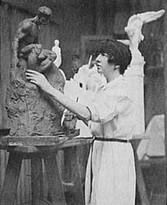Titanic Memorial
Introduction
Text-to-speech Audio
Images
Titanic Memorial
.jpg)
Titanic

Gertrude Vanderbilt Whitney (1875-1942) at work in her studio (c. 1920)

Backstory and Context
Text-to-speech Audio
On April 10, 1912, the British luxury passenger liner RMS Titanic left Southampton, England on its maiden voyage across the Atlantic Ocean. After making quick stops to pick up additional passengers in Cherbourg, France and Queenstown, Ireland, the ship steamed for its ultimate destination, New York City. Just before midnight on Sunday, April 14, Titanic struck an iceberg, which tore a long gash on the starboard side of its hull. Just over two and a half hours later, the vessel once touted as unsinkable was at the bottom of the North Atlantic Ocean. Out of the approximately 2,200 passengers and crew members onboard, only about 700 survived the tragedy. Due to the ship’s evacuation policy, which mandated that women and children be the first passengers to be loaded onto the insufficient number of lifeboats, most of the survivors were women and children. The men who died in the disaster came from practically all walks of life. Some were poor immigrants who had scrapped together just enough money to purchase tickets in steerage, while others, such as John Jacob Astor, were some of the wealthiest men in the world.
Shortly after the tragedy, which garnered international attention, a group of American women founded the Women’s Titanic Memorial Association. Led by Mrs. John Hays Hammond, the organization raised $43,000 by January 1914 to erect a monument honoring the men aboard the RMS Titanic who sacrificed their lives so that the women and children could live. Most of the donations were small and made by thousands of women from across the United States. The association also sponsored a design competition for its proposed memorial. Several esteemed sculptors submitted entries, but the Women’s Titanic Memorial Association chose that of a relatively unknown artist at the time, Gertrude Vanderbilt Whitney (1875-1942). It would be the first significant commission of her career.
Although completed in 1916, the memorial was not dedicated until 1931. For about fifteen years, it remained in a private gallery in New York City while the Women’s Titanic Memorial Association obtained the necessary approvals and construction crews prepared the site. Originally, the memorial was located along the Potomac River at the southern end of New Hampshire Avenue. In 1968, it was dismantled to make way for the construction of the John F. Kennedy Center for the Performing Arts. The memorial sat in storage briefly before being relocated to Southwest Waterfront Park, where it remains today.
The memorial is composed of a few different parts. The first is a red granite sculpture of a partially cloaked male figure. He stands tall with both arms stretched wide open. His eyes are closed and his head is tiled back as if beckoning to the sky above. The figure stands on a pedestal inscribed with the following: “TO THE YOUNG AND THE OLD THE RICH AND THE POOR THE IGNORANT AND THE LEARNED ALL WHO GAVE THEIR LIVES NOBLY TO SAVE WOMEN AND CHILDREN.” The pedestal is integrated into the center of a thirty-foot-long exedra designed by renowned architect Henry Bacon, who also designed the Lincoln Memorial.
Sources
History.com Editors. "Titanic Sinks." History. A&E Television Networks. 13 April 2020. Web. 18 November 2020 <https://www.history.com/this-day-in-history/titanic-sinks>.
"Titanic." Encyclopaedia Britannica. Web. 18 November 2020 <https://www.britannica.com/topic/Titanic>.
"Titanic Memorial." National Register of Historic Places Nomination Form. National Parks Service. U.S. Department of the Interior. Web. 18 November 2020 <https://historicsites.dcpreservation.org/items/show/598>.
https://en.wikipedia.org/wiki/Titanic_Memorial_(Washington,_D.C.)
https://www.britannica.com/topic/Titanic
http://xroads.virginia.edu/~museum/Armory/gender.html
